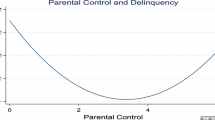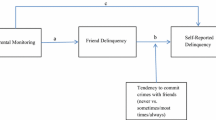Abstract
Adolescence and young adulthood are periods of increased autonomy. Higher levels of autonomy could increase the opportunities for risky behavior such as delinquency. During these periods of transition, the role of parental control becomes less clear. Previous studies have demonstrated the association between parental control and adolescent delinquency, but few have extended examination of such association into young adulthood. The purpose of the study is to examine the association between parental control and delinquency and parental control in adolescence and young adult criminal behavior. We propose that, even though adolescents seek autonomy during this stage, lack of parental control is positively associated with delinquency and has continued influence in young adulthood. Using a national longitudinal dataset, we analyzed the relationship between parental control and delinquency. Findings from regression analyses indicated that lack of parental control had a positive association with delinquency both concurrently and longitudinally into young adulthood. When analyzing delinquency in young adulthood, females reported a lower level of delinquency and younger age was associated with more delinquent behavior. Unexpectedly, parents’ college education was positively associated with delinquency in young adulthood. The findings suggest that parental control is still influential through the period of adolescence and early parental control is still influential in young adulthood. Ways to practice parental control and implications of results are further discussed.
Similar content being viewed by others
References
Arnett, J. J. (2000). Emerging adulthood: A theory of development from late teens through twenties. American Psychologist, 55, 469–480.
Barnes, G. M., Hoffman, J. H., Welte, J. W., Farrell, M. P., & Dintcheff, B. A. (2006). Effects of parental monitoring and peer deviance on substance use and delinquency. Journal of Marriage and Family, 68, 1084–1104.
Baumrind, D. (1965). Parental control and parental love. Children, 12, 230–234.
Baumrind, D. (1967). Child care practices anteceding three patterns of preschool behavior. Genetic Psychology Monographs, 75, 43–88.
Baumrind, D. (2005). Patterns of parental authority and adolescent autonomy. New Directions for Child and Adolescent Development, 108, 61–69.
Bean, R. A., Barber, B. K., & Crane, D. R. (2006). Parental support, behavioral control, and psychological control among African American youth: The relationships to academic grades, delinquency, and depression. Journal of Family Issues, 27, 1335–1355.
Blum, R. W., Beuhring, T., Shew, M. L., Bearinger, L. H., Sieving, R. E., & Resnick, M. D. (2000). The effects of race/ethnicity, income, and family structure on adolescent risk behavior. American Journal of Public Health, 90, 1879–1884.
Borawksi, E. A., Ievers-Landis, C. E., Lovegreen, L. D., & Trapl, E. S. (2003). Parental monitoring negotiated unsupervised time and parental trust: The role of perceived parenting practices in adolescent health risk behaviors. Journal of Adolescent Health, 33, 60–70.
Cavanagh, S. E., Crissey, S. R., & Raley, R. K. (2008). Family structure history and adolescent romance. Journal of Marriage and Family, 70, 698–714.
Chantala, K. (2006). Guidelines for analyzing Add Health data. Chapel Hill, NC: Carolina Population Center, University of North Carolina at Chapel Hill.
Chantala, K., & Tabor, J. (1999). Strategies to perform a design-based analysis using the Add Health data. Chapel Hill, NC: Carolina Population Center, University of North Carolina at Chapel Hill.
Chen, X. (2010). Desire for autonomy and adolescent delinquency: a latent growth curve analysis. Criminal Justice and Behavior, 37, 989–1004.
Cottrell, L., Li, X., Harris, C., D’Alessandri, D., Atkins, M., Richardson, B., et al. (2003). Parent and adolescent perceptions of parenting monitoring and adolescent risk involvement. Parenting Science and Practice, 3, 179–195.
Cui, M., Donnellan, M. R., & Conger, R. D. (2007). Reciprocal influences between parents’ marital problems and adolescent internalizing and externalizing behavior. Developmental Psychology, 43, 1544–1552.
Demuth, S., & Brown, S. L. (2004). Family structure, family processes, and adolescent delinquency: The significance of parental absence versus parental gender. Journal of Research in Crime and Delinquency, 41, 58–81.
Elder, G. H. (1985). Life course dynamics: Trajectories and transitions, 1968–1980. Ithaca, New York: Cornell University Press.
Erikson, E. H. (1968). Identity: Youth and crisis. NY: Norton & Company.
Griffin, K. W., Botvin, G. J., Schier, L. M., Diaz, T., & Miller, N. L. (2000). Parenting practices as predictors of substance use, delinquency, and aggression among urban minority youth: Moderating effects of family structure and gender. Psychology of Addictive Behaviors, 14, 174–184.
Hall, G. S. (1904). Adolescence: Its psychology and its relation to physiology, anthropology, sociology, sex, crime, religion, and education (Vols. I & II). Englewood Cliffs, NJ: Prentice-Hall.
Harris, K. M., Halpern, C. T., Entzel, P., Tabor, J., Bearman, P. S., & Udry, J. R. (2008). The National Longitudinal Study of Adolescent Health: Research design [www document]. URL: http://www.cpc.unc.edu/projects/addhealth/design.
Haynie, D. L. (2003). Contexts of risk? Explaining the link between girls’ pubertal development and their delinquency involvement. Social Forces, 82, 355–397.
Hoeve, M., Blokland, A., Semon Dubas, J., Loeber, R., Gerris, J. R. M., & van der Laan, P. H. (2008). Trajectories of delinquency and parenting styles. Journal of Abnormal Child Psychology, 36, 223–235.
Hoeve, M., Semon Dubas, J., Eichelsheim, V. I., van der Laan, P. H., Smeenk, W., & Gerris, J. R. M. (2009). The relationship between parenting and delinquency: A meta-analysis. Journal of Abnormal Child Psychology, 37, 749–775.
Kowaleski-Jones, L., & Duniforn, R. (2006). Family structure and community context: Evaluating influences on adolescent outcomes. Youth & Society, 38, 110–130.
Maccoby, E. E., & Martin, J. A. (1983). Socialization in the context of the family: Parent-child interaction. In P. Mussen (Ed.), Handbook of child psychology Vol.4. New York: Wiley.
Mack, K. Y., & Leiber, M. J. (2005). Race, gender, single-mother households, and delinquency. Youth & Society, 37, 115–144.
McCord, J. (1990). Problem behaviors. In S. S. Feldman & G. R. Elliot (Eds.), At the threshold: The developing adolescent (pp. 414–430). Cambridge: Harvard University Press.
Moffitt, T. E. (1993). Adolescence-Limited and life-course-persistent antisocial behavior: A developmental taxonomy. Psychological Review, 4, 674–701.
Moffitt, T. E., & Caspi, A. (2001). Childhood predictors differentiate life-course persistent and adolescence-limited antisocial pathways among males and females. Development and Psychopathology, 13, 355–375.
Moore, J. & Hagedorn, J., Department of Justice, Office of Juvenile Justice and Delinquency Prevention. (2001). Female gangs: A focus on research (NCJ Publication No. 188159). Retrieved from http://www.ncjrs.gov/pdffiles1/ojjdp/188159.pdf.
Morgo-Wilson, C. (2007). The influence of parental warmth and control on Latino adolescent alcohol use. Hispanic Journal of Behavioral Sciences, 30, 89–105.
Mulvey, E. (2011). Highlights from pathways to desistance: A longitudinal study of serious adolescent offenders. Office of Juvenile Justice and Delinquency Prevention NCJ 230971.
Mulvey, E.P, Schubert, C.A. Chassin, L. Department of Justice, Office of Juvenile Justice and Delinquency Prevention (2010). Substance abuse and delinquent behavior among serious adolescent offenders. (NCJ Publication No. 232790). Retrieved from https://www.ncjrs.gov/pdffiles1/ojjdp/232790.pdf.
Nelson, L. J., Padilla-Walker, L. M., Christensen, K. J., Evans, C. A., & Carroll, J. S. (2011). Parenting in young adulthood: An examination of parenting clusters and correlates. Journal of Youth and Adolescence, 40, 730–743.
Nye, I. F. (1958). Family relationships and delinquent behavior. Westport, CT: Greenwod Press.
Piquero, A.R., Brame, R., Mazerolle, P., & Haapanen, R. (2001). Crime in emerging adulthood: Continuity and change in criminal offending (NCJ Publication 186735). Retrieved from https://www.ncjrs.gov/pdffiles1/nij/grants/186735.pdf.
Puzzanchera, C., Department of Justice, Office of Juvenile Justice and Delinquency Prevention. (2008). Juvenile arrest 2008 (NCJ Publication No. 228479). Retrieved from http://www.ncjrs.gov/pdffiles1/ojjdp/228479.pdf.
Robbins, L. N. (1966). Deviant children grown up: A sociological and psychiatric study of sociopathic personality. Baltimore: Williams & Wilkins Company.
Sameoff, A. J., Peck, S. C., & Eccles, J. S. (2004). Changing ecological determinants of conduct problems from early adolescence to early adulthood. Development and Psychopathology, 16, 873–896.
Sampson, R. J., & Laub, J. H. (1993). Crime in the making: Pathways and turning points through life. Cambridge: Harvard University Press.
Schroeder, R. D., Bulanda, R. E., Giordana, P. C., & Cernkovich, S. A. (2010). Parenting and adult criminality: An examination of direct and indirect effects by race. Journal of Adolescent Research, 25, 64–98.
Seydlitz, R. (1991). The effects of age and gender on parental control and delinquency. Youth & Society, 23, 175–201.
Smetana, J., Crean, H. F., & Campione-Barr, N. (2005). Adolescents’ and parents’ changing conceptions of parental authority. New Directions for Child and Adolescent Development, 108, 31–46.
Steinberg, L. (1990). Autonomy, conflict, and harmony in the family relationship. In S. S. Feldman & G. R. Elliot (Eds.), At the threshold: The developing adolescent (pp. 255–276). Cambridge: Harvard University Press.
Steinberg, L., & Silk, J. S. (2002). Parenting adolescents. In M. H. Bornstein (Ed.), Handbook of parenting children and parenting (Vol. 1, pp. 103–133). Mahwah, NJ: Lawrence Erlbaum.
Acknowledgments
This study uses data from Add Health, a program project directed by Kathleen Mullan Harris and designed by J. Richard Udry, Peter, S. Bearman, and Kathleen Mullan Harris at the University of North Carolina at Chapel Hill, and funded by a grant P01-HD31921 from the National Institute of Child Health and Human Development, with cooperative funding from 23 other federal agencies and foundations. Special acknowledgement is due Ronald R. Rindfuss and Barbara Entwisle for assistance in the original design. Information on how to obtain the Add Health data files is available on the Add Health website (http://www.cpc.unc.edu/addhealth). No direct support was received from grant P01-HD31921 for this analysis.
Author information
Authors and Affiliations
Corresponding author
Rights and permissions
About this article
Cite this article
Harris-McKoy, D., Cui, M. Parental Control, Adolescent Delinquency, and Young Adult Criminal Behavior. J Child Fam Stud 22, 836–843 (2013). https://doi.org/10.1007/s10826-012-9641-x
Published:
Issue Date:
DOI: https://doi.org/10.1007/s10826-012-9641-x




